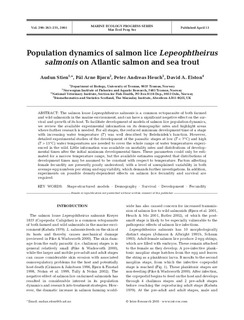Population dynamics of salmon lice Lepeophtheirus salmonis on Atlantic salmon and sea trout
Journal article, Peer reviewed
Permanent lenke
http://hdl.handle.net/11250/108613Utgivelsesdato
2005-04-13Metadata
Vis full innførselSamlinger
- Articles [3012]
Originalversjon
http://dx.doi.org/10.3354/meps290263Sammendrag
The salmon louse Lepeophtheirus salmonis is a common ectoparasite of both farmed and wild salmonids in the marine environment, and can have a significant negative effect on the survival and growth of its host. To facilitate development of models of salmon lice population dynamics, we review the available experimental information on its demographic rates and highlight areas where further research is needed. For all stages, the reduced minimum development time of a stage with increasing water temperature (T) was well described by Belehrádek’s function. However, detailed experimental studies of the development of the parasitic stages at low (T < 7°C) and high (T > 15°C) water temperatures are needed to cover the whole range of water temperatures experienced in the wild. Little information was available on mortality rates and distributions of developmental times after the initial minimum developmental times. These parameters could only be estimated for a narrow temperature range, but the available estimates suggested that distributions of development times may be assumed to be constant with respect to temperature. Factors affecting female fecundity are presently poorly understood, with a level of unexplained variability in both average egg numbers per string and egg viability, which demands further investigations. In addition, experiments on possible density-dependent effects on salmon lice fecundity and survival are required.
